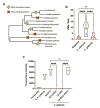Zinc prevents vaginal candidiasis by inhibiting expression of an inflammatory fungal protein
- PMID: 38055800
- PMCID: PMC7616067
- DOI: 10.1126/scitranslmed.adi3363
Zinc prevents vaginal candidiasis by inhibiting expression of an inflammatory fungal protein
Abstract
Candida causes an estimated half-billion cases of vulvovaginal candidiasis (VVC) every year. VVC is most commonly caused by Candida albicans, which, in this setting, triggers nonprotective neutrophil infiltration, aggressive local inflammation, and symptomatic disease. Despite its prevalence, little is known about the molecular mechanisms underpinning the immunopathology of this fungal infection. In this study, we describe the molecular determinant of VVC immunopathology and a potentially straightforward way to prevent disease. In response to zinc limitation, C. albicans releases a trace mineral binding molecule called Pra1 (pH-regulated antigen). Here, we show that the PRA1 gene is strongly up-regulated during vaginal infections and that its expression positively correlated with proinflammatory cytokine concentrations in women. Genetic deletion of PRA1 prevented vaginal inflammation in mice, and application of a zinc solution down-regulated expression of the gene and also blocked immunopathology. We also show that treatment of women suffering from recurrent VVC with a zinc gel prevented reinfections. We have therefore identified a key mediator of symptomatic VVC, giving us an opportunity to develop a range of preventative measures for combatting this disease.
Conflict of interest statement
Competing interests:
Peter Takacs a paid consultant for: Fempharma LLC (Hungary), Materna Medical LLC (USA), Chemical Works of Gedeon Richter Plc. (Hungary) and holds: U.S. Patent: 9,375,450 Title: Vaginal tissue rejuvenation and compositions and methods; U.S. Patent Application: 63456387 Title: Pharmaceutical composition and method for treating candidiasis. Bence Kozma is an unpaid consultant for Fempharma LLC (Hungary). The other authors declare that they have no competing interests.
Figures





References
-
- Zhu YX, Li T, Fan SR, Liu XP, Liang YH, Liu P. Health-related quality of life as measured with the Short-Form 36 (SF-36) questionnaire in patients with recurrent vulvovaginal candidiasis. Health Qual Life Outcomes. 2016;14:65. doi: 10.1186/s12955-016-0470-2. published online EpubApr 29. - DOI - PMC - PubMed
-
- Sobel JD, Wiesenfeld HC, Martens M, Danna P, Hooton TM, Rompalo A, Sperling M, Livengood C, 3rd, Horowitz B, Von Thron J, Edwards L, et al. Maintenance fluconazole therapy for recurrent vulvovaginal candidiasis. The New England journal of medicine. 2004;351:876–883. doi: 10.1056/NEJMoa033114. published online Epub Aug 26. - DOI - PubMed
MeSH terms
Substances
Grants and funding
LinkOut - more resources
Full Text Sources
Other Literature Sources

